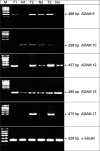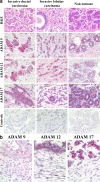Increased expression of ADAM family members in human breast cancer and breast cancer cell lines
- PMID: 15565459
- PMCID: PMC12161180
- DOI: 10.1007/s00432-004-0619-y
Increased expression of ADAM family members in human breast cancer and breast cancer cell lines
Abstract
Purpose: ADAMs (A Disintegrin and Metalloprotease) are multifunctional, membrane-bound cell surface glycoproteins, which have numerous functions in cell growth, differentiation, and motility. We wished to investigate the expression of ADAM 9, 10, 12, 15, and in human breast cancer.
Methods: Expression of ADAMs was determined in breast cancer specimens and the corresponding non-neoplastic breast tissue from 24 patients, and in the MCF-7 and MDA-MB 453 breast cancer cell lines via quantitative RT-PCR and immunohistochemistry. The effects of anti-ADAM antibodies on cell proliferation were assessed by measuring DNA-synthesis.
Results: Breast cancer tissue samples showed increased mRNA expression of ADAM 9, 12, and 17, whereas ADAM 10 and 15 were not differently expressed. Protein expression was studied by immunohistochemistry. All ADAMs were expressed in MCF-7 and MDA-MB453 cell lines, with the highest expression levels being observed for ADAM 9, 12, and 17. Application of anti-ADAM 15 and anti-ADAM 17 antibodies significantly inhibited the proliferation of both MCF-7 and MDA-MB453 breast cancer cell lines. In contrast, the growth of MCF-7 cells appeared to be stimulated by the administration of anti-ADAM 12 antibody.
Conclusion: The results of this study suggest that ADAMs are differentially expressed in human breast cancer and are capable of modulating tumour cell growth.
Figures





Similar articles
-
Prognostic value of intercellular adhesion molecule (ICAM)-1 expression in breast cancer.J Cancer Res Clin Oncol. 2011 Aug;137(8):1193-201. doi: 10.1007/s00432-011-0984-2. Epub 2011 May 18. J Cancer Res Clin Oncol. 2011. PMID: 21590495 Free PMC article.
-
Unveiling miRNA30b's Role in Suppressing ADAM12 to Combat Triple-Negative Breast Cancer.Breast J. 2024 Oct 30;2024:5202941. doi: 10.1155/2024/5202941. eCollection 2024. Breast J. 2024. PMID: 39742357 Free PMC article.
-
Reduced metastasis-suppressor gene mRNA-expression in breast cancer brain metastases.J Cancer Res Clin Oncol. 2005 Mar;131(3):191-8. doi: 10.1007/s00432-004-0629-9. Epub 2004 Dec 8. J Cancer Res Clin Oncol. 2005. PMID: 15592684 Free PMC article.
-
First trimester serum tests for Down's syndrome screening.Cochrane Database Syst Rev. 2015 Nov 30;2015(11):CD011975. doi: 10.1002/14651858.CD011975. Cochrane Database Syst Rev. 2015. PMID: 26617074 Free PMC article.
-
The Biochemistry and Physiology of A Disintegrin and Metalloproteinases (ADAMs and ADAM-TSs) in Human Pathologies.Rev Physiol Biochem Pharmacol. 2023;184:69-120. doi: 10.1007/112_2021_67. Rev Physiol Biochem Pharmacol. 2023. PMID: 35061104 Review.
Cited by
-
ADAM10 Sheddase Activity is a Potential Lung-Cancer Biomarker.J Cancer. 2018 Jun 23;9(14):2559-2570. doi: 10.7150/jca.24601. eCollection 2018. J Cancer. 2018. PMID: 30026855 Free PMC article.
-
Phenotypic diversity of breast cancer-related mutations in metalloproteinase-disintegrin ADAM12.PLoS One. 2014 Mar 20;9(3):e92536. doi: 10.1371/journal.pone.0092536. eCollection 2014. PLoS One. 2014. PMID: 24651654 Free PMC article.
-
ADAM9 is highly expressed in renal cell cancer and is associated with tumour progression.BMC Cancer. 2008 Jun 26;8:179. doi: 10.1186/1471-2407-8-179. BMC Cancer. 2008. PMID: 18582378 Free PMC article.
-
ADAM15 disintegrin is associated with aggressive prostate and breast cancer disease.Neoplasia. 2006 Apr;8(4):319-29. doi: 10.1593/neo.05682. Neoplasia. 2006. PMID: 16756724 Free PMC article.
-
Therapeutic potential of targeting the Eph/ephrin signaling complex.Int J Biochem Cell Biol. 2018 Dec;105:123-133. doi: 10.1016/j.biocel.2018.10.006. Epub 2018 Oct 19. Int J Biochem Cell Biol. 2018. PMID: 30343150 Free PMC article. Review.
References
-
- Ansorge S, Reinhold D, Lendeckel U (2003) Propolis and some of its constituents down-regulate DNA synthesis and inflammatory cytokine production but induce TGF-beta1 production of human immune cells. Z Naturforsch 58:580–589 - PubMed
-
- Asai M, Hattori C, Szabo B, Sasagawa N, Maruyama K, Tanuma S, Ishiura S (2003) Putative function of ADAM9, ADAM10, and ADAM17 as APP alpha-secretase. Biochem Biophys Res Commun 301:231–235 - PubMed
-
- Black RA and White J M (1998) ADAMs: focus on the protease domain. Curr Opin Cell Biol 10:654–659 - PubMed
-
- Black RA, Rauch CT, Kozlosky CJ, Peschon JJ, Slack JL, Wolfson MF, Castner BJ, Stocking KL, Reddy P, Srinivasan S, Nelson N, Boiani N, Schooley KA, Gerhart M, Davis R, Fitzner JN, Johnson RS, Paxton RJ, March CJ, Cerretti DP (1997) A metalloproteinase disintegrin that releases tumour-necrosis factor-alpha from cells. Nature 385:729–733 - PubMed
Publication types
MeSH terms
Substances
LinkOut - more resources
Full Text Sources
Other Literature Sources
Medical
Miscellaneous

